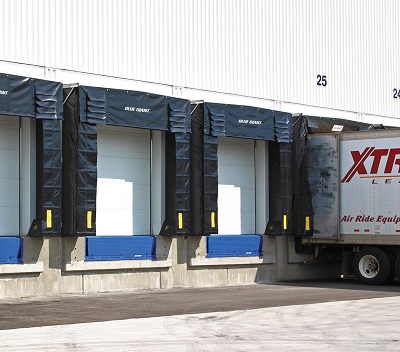
MHI’s Loading Dock Equipment Manufacturers (LODEM) Industry Group helps protect workers from potential hazards that could cause severe injuries and even deaths.
Loading dock safety took “a completely different turn” in 1980 with the advent of the vehicle restraint industry and, now, all of the major manufactures in the LODEM group offer vehicle restraints, said Chad Dillavou, director of product management at MHI member Rite-Hite Products Corp.
Before this, in 1978, the Occupational Safety and Health Administration (OSHA) had mandated the use of wheel chocks on tractor-trailers at docks while they loaded and unloaded, to keep trailers from separating from the dock and causing forklifts to fall off the edge of the dock.
“Not only could truck drivers depart prematurely, but the energy caused by forklifts moving in and out of trailers could cause trailers to inch away from docks,” he said. “Moreover, while a wheel chock helps prevent accidents when trailers move away from docks in a horizontal fashion, they don’t prevent separation in a vertical fashion if the trailer tips up.”
The National Highway Traffic Safety Administration requires trailers to be equipped with an under-ride guard, or rear impact guard, Dillavou said. In this instance, a rotating hook vehicle restraint has a hook that wraps up and around the trailer holding it to the dock both horizontally and vertically.
The rotating hook restraint helps prevent vertical movement of the trailer, which can happen when landing gear propping the tractor-less trailer becomes worn and collapses, causing the rear of the trailer to spring up, he said. Alternatively, the trailer can tip up if a forklift has a very heavy load and drives into the nose of the trailer, causing the landing gear to act as a fulcrum.
If only wheel chocks are used, they should be paired with traffic-style lights that serve as a communication system for both truck drivers and people inside buildings, Dillavou said.
“When a light outside the building is green signifying to truck drivers that it’s safe to depart, there is a corresponding light inside the building that is red signifying that it’s not safe to load or unload their trailers,” he said. “Conversely, red on the outside means it’s not safe to depart, while green on the inside means it’s safe to load or unload trailers.”
OSHA cites nearly 7,000 accidents each year where a forklift drives off the face of the dock and crashes 48 inches or more to the drive approach, he said. To help prevent such accidents, in addition to vehicle restraints, manufacturers within the LODEM group make solutions such as barrier lips or “safety lips” on the dock leveler, which create a 5-inch to 7-inch barrier to keep the forklift inside the builder, should the dock position not have a trailer in position. Additionally, there are free-standing barrier systems or guard systems that can keep forklifts inside the building and are independent of a dock leveler or vehicle restraint.
“Inside the building, blue lights on forklifts are a great step to help prevent accidents with pedestrians,” Dillavou said. “That blue light however, disappears into the trailer during loading and unloading. To mitigate that, there are systems that detect motion inside of the trailer and project a blue light on the leveler, telling pedestrians and other material handlers that a forklift is in the trailer and will be exiting soon.”
 MHI Solutions Improving Supply Chain Performance
MHI Solutions Improving Supply Chain Performance